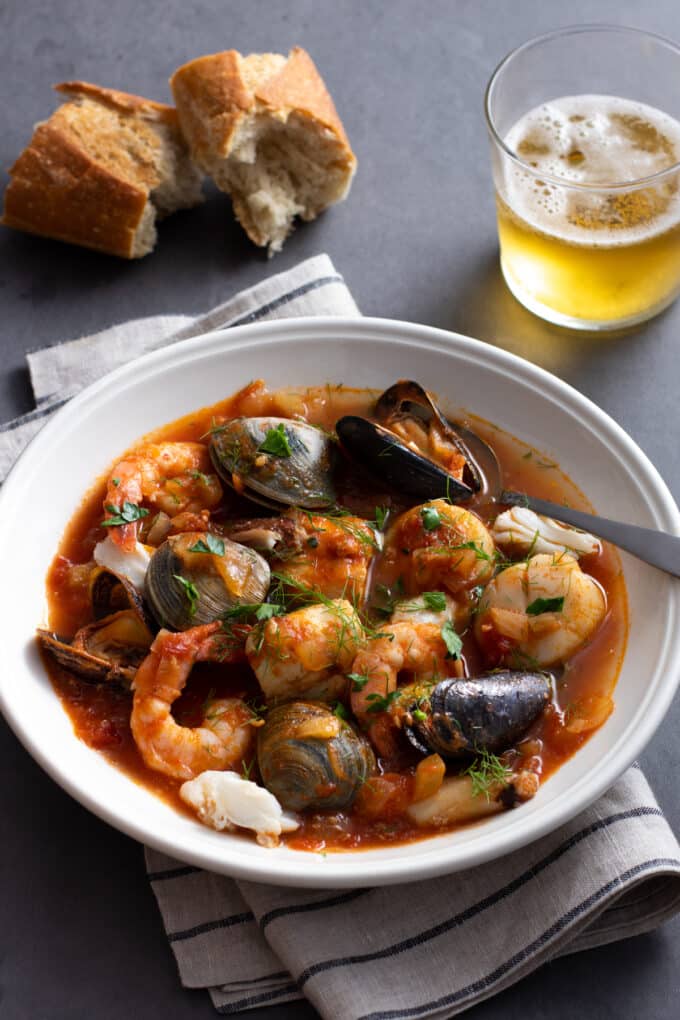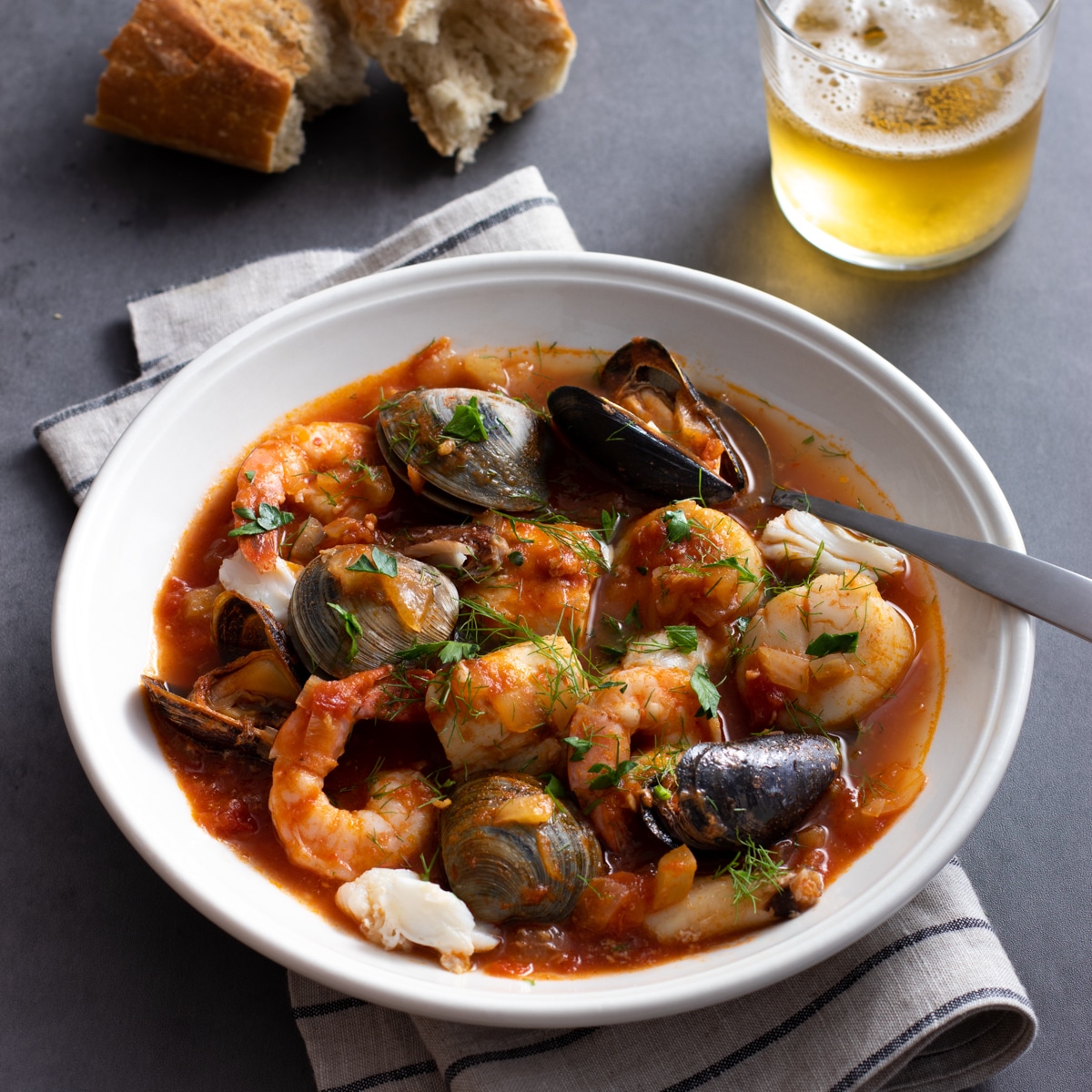Cioppino is a true celebration of seafood—a tomato-based stew jam-packed with fish and shellfish. Make it using all your favorites, then serve it with crusty bread to sop up every delicious drop!
You’ve probably heard of bouillabaisse, but have you heard of Cioppino?
I’ve heard of it a lot because I live near San Francisco, where Cioppino comes from. It’s one of the city’s most beloved culinary inventions, along with Ghirardelli chocolate and sourdough bread (which happens to go very well with Cioppino!).

But What Is Cioppino?
Although it was invented in San Francisco, Cioppino is closely related to seafood stews throughout the Mediterranean, including bouillabaisse. The story goes that Italian fisherman who settled in San Francisco’s North Beach brought with them the tradition of making a rustic stew out of the day’s catch—but then made it their own by incorporating the various types of seafood available on the Pacific.
So that’s the first thing that distinguishes Cioppino—it’s typically jam-packed with West Coast seafood, including fish, clams, mussels, shrimp, scallops, and crab, while bouillabaisse is more about Mediterranean fish and not necessarily shellfish. Cioppino is also flavored with tomato, fennel, and some form of peppers, while bouillabaisse is flavored with tomato, fennel, saffron, and orange zest.
Bottom line, Cioppino is similar to almost any tomato-based seafood stew you’re familiar with. But perhaps more than others, it’s a celebration of all kinds of seafood. (If you’re a seafood lover, you might also like this Seafood Pasta recipe.)
Choosing Your Seafood
Do its West Coast roots mean you can’t make Cioppino in the South, East, or Mid-West? Absolutely not. Just use the recipe below to celebrate the seafood available where you live.
Since this post is part of a series about types of white fish, let’s start with that. Technically, for Cioppino you can use any white fish that you like and that’s available. But I recommend a meatier, less delicate fish that won’t break up too much in the pot like halibut, sturgeon, or swordfish.
For the shellfish, my recipe includes clams, mussels, shrimp, scallops, and crab. If you don’t like or can’t find any of those, just omit it and substitute a little more of something else. Ideally, there should be a lot of variety—but according to me at least, what’s most important is using seafood you enjoy, seafood that’s good quality, and seafood that lauds your local catch. And lots of it.
A word about the crab. Many recipes include in-shell pieces—whole claws, leg segments, like that. But that can make for a messy eating experience. So my recipe uses shelled lump crabmeat, turning it into what’s known as Lazy Man’s Cioppino. Add it gently at the end to keep it from breaking up too much.
Making And Serving Cioppino
Making Cioppino is pretty easy, but admittedly it’s not quick. You can, however, make the stew base (through step 4 below) in advance, then refrigerate or freeze it. When you’re ready to serve, bring the base back to a simmer, add the seafood, and it’s less than 10 minutes to mealtime. This works great for a dinner party or simply a busy weeknight.
On the side, only one thing is required—crusty San Francisco sourdough. To celebrate Cioppino’s home, for sure. But also to sop up every delicious drop.
Print
Cioppino
Cioppino is a true celebration of seafood—a tomato-based stew jam-packed with fish and shellfish. Make it using all your favorites, then serve it with crusty bread to sop up every delicious drop!
If you’d rather not make the Cioppino all at once, just make the stew base (through step 4), then refrigerate or freeze it. When you’re ready to serve, bring the base back to a simmer, and continue at step 5.
- Prep Time: 45 minutes
- Cook Time: 50 minutes
- Total Time: 1 hour 35 minutes
- Yield: 8 servings 1x
- Category: Entrée
- Method: Stovetop
- Cuisine: American
Ingredients
- 1/4 cup olive oil
- 2 bulbs fennel, diced, plus 1/4 cup chopped feathery fennel fronds, divided
- 1 large yellow onion, diced
- 6 garlic cloves, minced
- 1/2 tsp. red pepper flakes
- 2 Tbsp. tomato paste
- 4 cups seafood broth, fish broth, or bottled clam juice
- 1 (28-oz.) can crushed tomatoes
- 1 cup dry white wine
- 2 tsp. salt, plus more to taste
- 1 lb. firm white fish fillets, such as halibut, sturgeon, or swordfish, or a combination, cut into 1 and 1/2-in. pieces
- 12 oz. sea scallops (see notes)
- 12 oz. large raw shrimp, peeled and deveined
- 12 small clams, scrubbed
- 12 mussels, scrubbed and debearded
- 8 oz. cooked lump crabmeat (see notes)
- 1/4 cup chopped fresh parsley
Instructions
- In a large saucepan or small stockpot over medium-high, heat the olive oil. Add the fennel and onion and cook, stirring occasionally, until tender, 6 to 8 minutes.
- Add the garlic and red pepper flakes and cook, stirring occasionally, until fragrant, 30 to 60 seconds.
- Add the tomato paste and cook, stirring almost constantly, until mixed in and fragrant, about 60 seconds.
- Add the broth, tomatoes, wine, and salt and bring to a boil. Reduce to a simmer and cook for 30 minutes.
- Arrange the fish, scallops, and shrimp on top of the broth. Arrange the clams and mussels on top. Increase the heat to medium-high and return to a boil. Reduce to a simmer, cover, and cook undisturbed until the clams and mussels are open and the fish, scallops, and shrimp are cooked through, 6 to 8 minutes (discard any clams or mussels that don’t open).
- Add more salt to taste, gently stirring to avoid breaking up the fish pieces.
- Add the crab, gently pressing it into the broth to warm it.
- Sprinkle with the parsley and fennel fronds.
Notes
Sea scallops are 1 and ½ to 2 inches large, as opposed to bay scallops, which are about ½ inch.
You can substitute cooked crab legs or smaller claws for the lump crabmeat, but getting the meat out of the shell at the table can make for slightly messy eating.